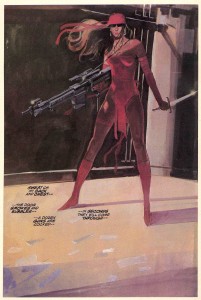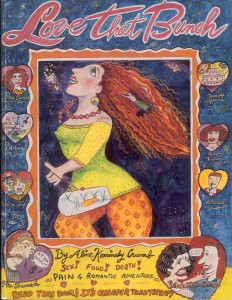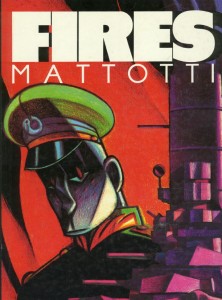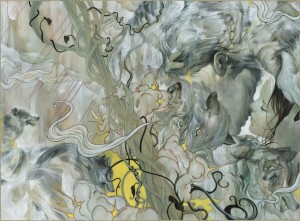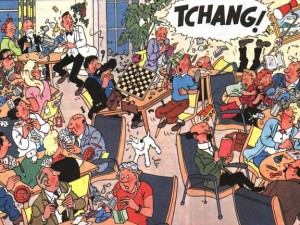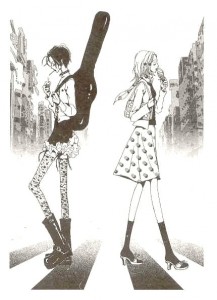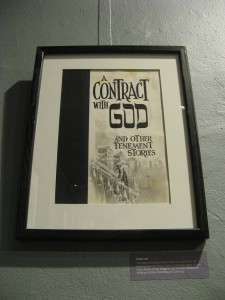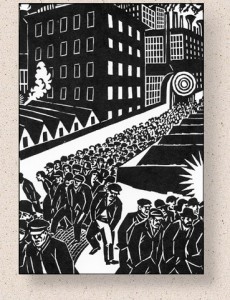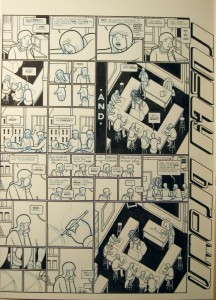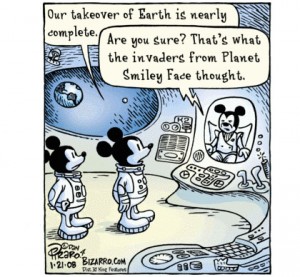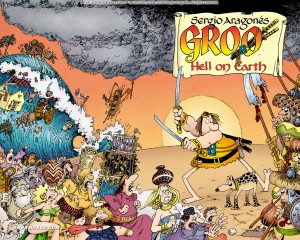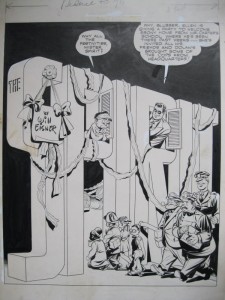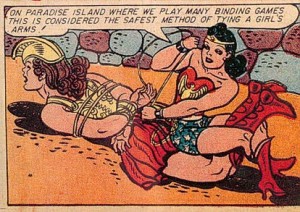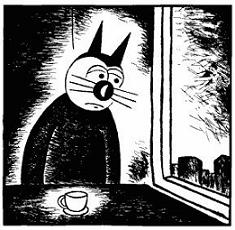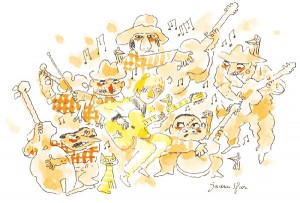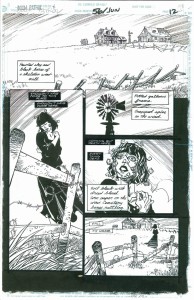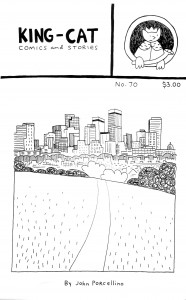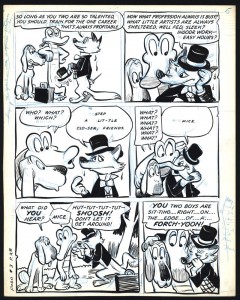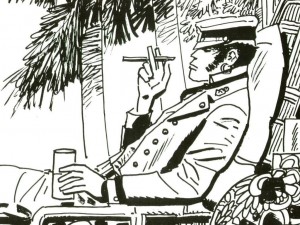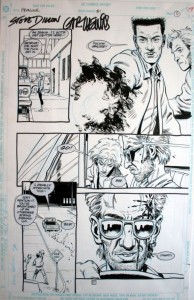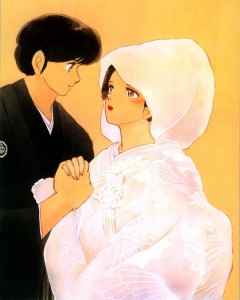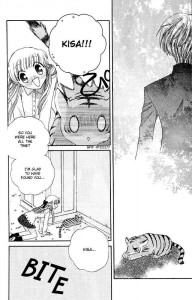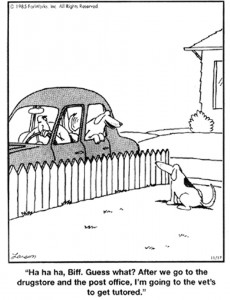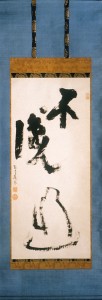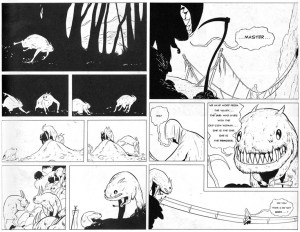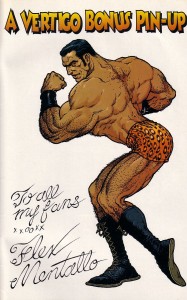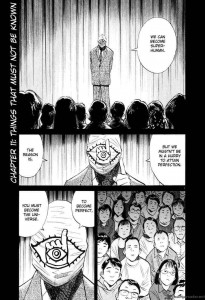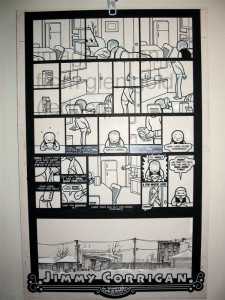The following lists were submitted in response to the question, “What are the ten comics works you consider your favorites, the best, or the most significant?” All lists have been edited for consistency, clarity, and to fix minor copy errors. Unranked lists are alphabetized by title. In instances where the vote varies somewhat with the Top 115 entry the vote was counted towards, an explanation of how the vote was counted appears below it.
In the case of divided votes, only works fitting the description that received multiple votes on their own received the benefit. For example, in Jessica Abel’s list, she voted for The Post-Superhero comics of David Mazzucchelli. That vote was divided evenly between Asterios Polyp and Paul Auster’s City of Glass because they fit that description and received multiple votes on their own. It was not in any way applied to the The Rubber Blanket Stories because that material did not receive multiple votes from other participants.
Matthew J. Brady
Writer, Warren Peace Sings the Blues
Elektra: Assassin, Frank Miller & Bill Sienkiewicz
- Elektra: Assassin, Frank Miller & Bill Sienkiewicz
- The Fourth World Stories, Jack Kirby, with Mike Royer, et al.
- Groo the Wanderer, Sergio Aragonés, with Mark Evanier, Tom Luth, and Stan Sakai
- Hi no Tori [Phoenix], Osamu Tezuka
- Kozure Ôkami [Lone Wolf and Cub], Kazuo Koike & Goseki Kojima
- Love and Rockets, Gilbert Hernandez & Jaime Hernandez
Counted as a 0.5 vote each for The Locas Stories, Jaime Hernandez, and The Palomar Stories, Gilbert Hernandez. - Monster, Naoki Urasawa
- 100 Bullets, Brian Azzarello & Eduardo Risso
- Promethea, Alan Moore & J. H. Williams III, with Mick Gray, et al.
- Seven Soldiers of Victory, Grant Morrison, et al.
Caroline Bren
Cartoonist, Young Youth; Writer,!!!!!!h4cked!!!!!!
The Autobiographical Stories, Aline Kominsky-Crumb
- The Autobiographical Stories, Aline Kominsky-Crumb
- Department of Art & Habitat, Dunja Jankovic
- Gensenkan Shujin [The Master of the Gensenkan Inn], Yoshiharu Tsuge
- Hôpital Brut, Caroline Sury & Pakito Bolino, editors
- The Kakuh stories, Hironori Kikuchi
- Koshihikari no Mita Yume [Dream of Koshihikari], Taneo Saito
- Maria no Komon [Mary’s Asshole], Hanako Yamada
- The Narrative Corpse, Art Spiegelman & R. Sikoryak, editors
- Nekojiru Udon, Nekojiru
- Weird Science #21, William M. Gaines, Al Feldstein, Ray Bradbury, Wallace Wood, Joe Orlando, Al Williamson, Frank Frazetta, and Jack Kamen
Counted as a vote for The EC Comics Science-Fiction Stories, Al Feldstein & Wallace Wood, Al Williamson, Joe Orlando, et al.
COMMENTS
Special Honors:
Horror comics curated by Karswell; Sorcery, Steve Jackson & John Blanche; Gadget, Haruhiko Shono
Casey Brienza
Contributing writer, The Journal of Popular Culture, Journal of Graphic Novels and Comics
Hanazakari no Niwa, Sakai Kunie
- Hanazakari no Niwa [Blooming Garden], Sakai Kunie
Scott O. Brown
Scriptwriter, Nightfall and Atlantis Rising
Black Hole, Charles Burns
- Black Hole, Charles Burns
- Calvin and Hobbes, Bill Watterson
- Jimmy Corrigan: The Smartest Kid on Earth, Chris Ware
- Maus: A Survivor’s Tale, Art Spiegelman
- New X-Men, Grant Morrison & Frank Quitely, et al.
- Nijusseiki Shônen [20th Century Boys], Naoki Urasawa
- The Sandman, Neil Gaiman, et al.
- Under a Slowly Spinning Sun, Marcel Guldemond
- Understanding Comics, Scott McCloud
Alex Buchet
Contributing writer, The Hooded Utilitarian
Fuochi [Fires], Lorenzo Mattotti
- Aruku Hito [The Walking Man], Jiro Taniguchi
- The Cartoons, Saul Steinberg
- Dreams of the Rarebit Fiend, Winsor McCay
- The EC Comics War Stories, Harvey Kurtzman & Jack Davis, John Severin, Wallace Wood, et al.
- Fuochi [Fires], Lorenzo Mattotti
- Journal, Fabrice Neaud
- Krazy Kat, George Herriman
- Lieutenant Blueberry, Jean-Michel Charlier & Jean “Moebius” Giraud
- MAD #1-28, Harvey Kurtzman & Will Elder, Wallace Wood, Jack Davis, et al.
- Prince Valiant, Hal Foster
Kurt Busiek
Co-creator & scriptwriter, Astro City; scriptwriter, Marvels
Fables, Bill Willingham & Mark Buckingham, et al.
- 1. Steve Canyon (1946-1960 strips), Milton Caniff
- 2. Terry and the Pirates, Milton Caniff
- 3. Kamandi, Jack Kirby, with Mike Royer
- 4. Mary Perkins On Stage, Leonard Starr
- 5. Pogo, Walt Kelly
- 6. Fables, Bill Willingham & Mark Buckingham, et al.
- 7. Bravo for Adventure, Alex Toth
- 8. She’s Josie, Frank Doyle & Dan DeCarlo
- 9. Maison Ikkoku, Rumiko Takahashi
- 10. The Sandman: Dream Country, Neil Gaiman, et al.
Sean Campbell
Writer, Don’t Cross the Streams
All-Star Superman, Grant Morrison & Frank Quitely
- All-Star Superman, Grant Morrison & Frank Quitely
- Batman: The Dark Knight Returns, Frank Miller, with Klaus Janson & Lynn Varley
- Batman: Year One, Frank Miller & David Mazzucchelli, with Richmond Lewis
- Bone, Jeff Smith
- Kingdom Come, Mark Waid & Alex Ross
- The League of Extraordinary Gentlemen, Volume I, Alan Moore & Kevin O’Neill
- Preacher, Garth Ennis & Steve Dillon
- The Sandman, Neil Gaiman, et al.
- The X-Men stories, Chris Claremont & John Byrne, with Terry Austin
- Y: The Last Man, Brian K. Vaughan & Pia Guerra, with José Marzán, Jr., et al.
Bruce Canwell
Associate Editor, Library of American Comics; scriptwriter, Batman: The Gauntlet
Tintin in Tibet, Hergé
- “Back to the Klondike,” starring Uncle $crooge, Carl Barks
- Batman: The Dark Knight Returns, Frank Miller, with Klaus Janson & Lynn Varley
- Calvin and Hobbes, Bill Watterson
- The Dreamer, Will Eisner
- From Hell, Alan Moore & Eddie Campbell
- Hadashi no Gen [Barefoot Gen], Keiji Nakazawa
- Maus: A Survivor’s Tale, Art Spiegelman
- The New Yorker cartoons, Charles Addams
- Terry and the Pirates, Milton Caniff
- Tintin in Tibet, Hergé
COMMENTS
Click here to read Bruce Canwell’s comments on his selections.
Greg Carter
Creator, writer Love Is in the Blood; co-creator, writer, Perfect Agent
Nana, Ai Yazawa
- Five Fists of Science, Matt Fraction & Steven Sanders
- Hopeless Savages, Jen Van Meter, et al.
- Kabuki, David Mack
- Nana, Ai Yazawa
- Nodame Kantâbire [Nodame Cantabile], Tomoko Ninomiya
- Paradigm Shift, Dirk Tiede
- Phonogram, Kieron Gillen & Jamie McKelvie
- Red String, Gina Biggs
- Strangers in Paradise, Terry Moore
COMMENTS
[On Kabuki] Scarab is my favorite single volume.
[On Hopeless Savages] Ground Zero is my favorite volume.
Scott Chantler
Cartoonist, Two Generals, Northwest Passage, and the Three Thieves series
A Contract With God and Other Tenement Stories, Will Eisner
- Batman: The Dark Knight Returns, Frank Miller, with Klaus Janson & Lynn Varley
- Belladone [Belladonna], Ange & Pierre Alary
- Calvin and Hobbes, Bill Watterson
- A Contract with God and Other Tenement Stories, Will Eisner
- From Hell, Alan Moore & Eddie Campbell
- Peanuts, Charles M. Schulz
- The Spirit, Will Eisner
- Tintin, Hergé
- Understanding Comics, Scott McCloud
- Watchmen, Alan Moore & Dave Gibbons
Jeffrey Chapman
Assistant Professor of English, Oakland University
The City, Frans Masereel
- 1. Maus: A Survivor’s Tale, Art Spiegelman
- 2. Krazy Kat, George Herriman
- 3. Peanuts, Charles M. Schulz
- 4. The ACME Novelty Library #20 (“Lint”) Chris Ware
Counted as a vote for Rusty Brown, including “Lint,” Chris Ware - 5. Fun Home, Alison Bechdel
- 6. Tintin, Hergé
- 7. Little Nemo in Slumberland, Winsor McCay
- 8. Buddha, Osamu Tezuka
- 9. The City, Frans Masereel
- 10. Asterios Polyp, David Mazzucchelli
Hillary L. Chute
Assistant Professor of English, University of Chicago; author, Graphic Women: Life Narrative and Contemporary Comics
A Child’s Life and Other Stories, Phoebe Gloeckner
- Black Hole, Charles Burns
- The ACME Novelty Library #18 (“Building Stories”), Chris Ware
- A Child’s Life and Other Stories, Phoebe Gloeckner
- The Fixer, Joe Sacco
- Fun Home, Alison Bechdel
- Ghost World, Daniel Clowes
- Love That Bunch, Aline Kominsky-Crumb
- Maus: A Survivor’s Tale, Art Spiegelman
- The Newspaper Strips, Winsor McCay
Counted as a 0.5 vote each for Dreams of the Rarebit Fiend and Little Nemo in Slumberland - ONE! HUNDRED! DEMONS!, Lynda Barry
Seymour Chwast
Illustrator & graphic designer extraordinaire; cartoonist, Dante’s Divine Comedy: A Graphic Adaptation
Little Nemo in Slumberland, Winsor McCay
- Little Nemo in Slumberland, Winsor McCay
Michael Clarke
Contributing writer, Communication, Culture & Critique and Television & New Media
Cerebus: Jaka’s Story, Dave Sim & Gerhard
- American Flagg!, Howard Chaykin
- Cerebus: High Society, Dave Sim & Cerebus: Jaka’s Story, Dave Sim & Gerhard
- David Boring, Daniel Clowes
- Elektra: Assassin, Frank Miller & Bill Sienkiewicz
- Le Garage hermétique [The Airtight Garage], Jean “Moebius” Giraud
- Hyôryû Kyôshitsu [The Drifting Classroom], Kazuo Umezu
- The Palomar Stories, Gilbert Hernandez
- Seven Soldiers of Victory, Grant Morrison, et al.
- X-Men: God Loves, Man Kills, Chris Claremont & Brent Anderson
Robert Clough
Writer, High-Low; contributing writer, The Comics Journal
Hicksville, Dylan Horrocks
- Approximativement [Approximate Continuum Comics], Lewis Trondheim
- Cecil & Jordan in New York, Gabrielle Bell
- Hate!, Peter Bagge
Counted as a vote for The Bradleys and The Buddy Bradley Stories, Peter Bagge - Hicksville, Dylan Horrocks
- Ice Haven, Daniel Clowes
- Life of the Party, Mary Fleener
- Recidivist #3, Zak Sally
- Safe Area Goradze, Joe Sacco
- Schizo, Ivan Brunetti
- Snake ‘n’ Bacon’s Cartoon Cabaret, Michael Kupperman
COMMENTS
This is one of those impossible questions, and my answers might tend to vary over time. My answers are a combo of what I think is “best” as well as those comics that drew (and draw) the most marked aesthetic reaction.
Brian Codagnone
Cartoonist, Misfits
Bloom County, Berkeley Breathed
- 1. Pogo, Walt Kelly
- 2. Peanuts, Charles M. Schulz
- 3. Li’l Abner, Al Capp
- 4. Calvin and Hobbes, Bill Watterson
- 5. Steve Canyon, Milton Caniff
- 6. Little Nemo in Slumberland, Winsor McCay
- 7. Bloom County, Berkeley Breathed
- 8. The Far Side, Gary Larson
- 9. Krazy Kat, George Herriman
- 10. Private Breger Abroad and Mister Breger, Dave Breger
Sean T. Collins
Writer, AttentionDeficitDisorderly; contributing writer, Robot 6 and The Comics Journal
Rusty Brown, Chris Ware
- 1. The ACME Novelty Library #20 (“Lint”) and #19 (Rusty Brown), Chris Ware
- 2. Jimmy Corrigan, the Smartest Kid on Earth, Chris Ware
- 3. The Diary of a Teenage Girl, Phoebe Gloeckner
- 4. The Palomar, Luba, and Fritz Stories, Gilbert Hernandez
- 5. Black Hole, Charles Burns
- 6. The Locas Stories, Jaime Hernandez
- 7. Batman: The Dark Knight Returns, Frank Miller, with Klaus Janson & Lynn Varley
- 8. The Fourth World Stories, Jack Kirby, with Mike Royer, et al.
- 9. “The Sunset,” Or Else #4, Kevin Huizenga
- 10. Big Questions, Anders Nilsen
Barry Corbett
Cartoonist, Ginger & Shadow and Embrace the Pun
Bizarro, Dan Piraro
- 1. Bizarro, Dan Piraro
- 2. Tales Designed to Thrizzle, Michael Kupperman
- 3. Ultimate Spider-Man, Brian Michael Bendis, Mark Bagley, and Stuart Immonen
- 4. Kingdom Come, Mark Waid & Alex Ross
- 5. Batman: The Cult, Jim Starlin & Bernie Wrightson, with Bill Wray
- 6. Li’l Abner, Al Capp
- 7. Maus: A Survivor’s Tale, Art Spiegelman
- 8. Magnus, Robot Fighter, Russ Manning
- 9. Ghost World, Daniel Clowes
- 10. The MAD Stories, Mort Drucker
Roberto Corona
Cartoonist, Welcome to Heck; penciler, Egypt
Daredevil: Born Again, Frank Miller & David Mazzucchelli
- 1. Calvin and Hobbes, Bill Watterson
- 2. Nexus, Mike Baron & Steve Rude, with Gary Martin, et al.
- 3. Daredevil: Born Again, Frank Miller & David Mazzucchelli
- 4. Hellboy, Mike Mignola
- 5. Hicksville, Dylan Horrocks
- 6. Understanding Comics, Scott McCloud
- 7. Bone, Jeff Smith
- 8. Cerebus, Dave Sim & Gerhard
- 9. Astérix le gaulois [Astérix the Gaul], René Goscinny & Albert Uderzo
- 10. Tank Girl, Jamie Hewlett & Alan Martin
Jamie Cosley
Cartoonist, Animal Office Funnies; illustrator, Priscilla
Groo the Wanderer, Sergio Aragonés, et al.
- Beanworld, Larry Marder
- Bone, Jeff Smith
- Calvin and Hobbes, Bill Watterson
- Groo the Wanderer, Sergio Aragonés, with Mark Evanier, Tom Luth, and Stan Sakai
- Hägar the Horrible, Dik Browne
- King Aroo, Jack Kent
- Land of Nod, Jay Stephens
- Tumbleweeds, T. K. Ryan
- The Uncle $crooge Stories, Don Rosa
- Usagi Yojimbo, Stan Sakai
Dave Coverly
Cartoonist, Speed Bump
The Spirit, Will Eisner
- Calvin and Hobbes, Bill Watterson
- The Editorial Cartoons, Jim Borgman
- Krazy Kat, George Herriman
- The MAD Cartoons, Sergio Aragonés
- The New Yorker Cartoons, George Booth
- Peanuts, Charles M. Schulz
- Pogo, Walt Kelly
- The Single-Panel Cartoons, B. Kliban
- The Single-Panel Cartoons, Quino
- The Spirit, Will Eisner
Warren Craghead
Cartoonist, How to Be Everywhere
The Codex Nutall
- 1. Peanuts, Charles M. Schulz
- 2. The Moon Fell on Me, Franklin Einspruch
- 3. The Yellow Kid, Richard F. Outcault
- 4. Krazy Kat, George Herriman
- 5. The Flash Stories, Cary Bates & Irving Novick
- 6. Works, Saul Steinberg
- 7. Frag, Ilan Manouach
- 8. The Codex Nuttall
- 9. “Yam Seal Land,” Andrei Molotiu
- 10. Jimbo’s Inferno, Gary Panter
Corey Creekmur
Associate Professor of English, The University of Iowa
Gasoline Alley, Frank King
- 1. Krazy Kat, George Herriman
- 2. Little Nemo in Slumberland, Winsor McCay
- 3. Gasoline Alley, Frank King
- 4. Frontline Combat, Harvey Kurtzman, editor
Counted as a vote for The EC Comics War Stories, Harvey Kurtzman & John Severin, Wallace Wood, Jack Davis, et al. - 5. Love & Rockets, Gilbert Hernandez & Jaime Hernandez
Counted as a 0.5 vote each for The Locas Stories, Jaime Hernandez, and The Palomar Stories, Gilbert Hernandez - 6. Jimmy Corrigan: The Smartest Kid on Earth, Chris Ware
- 7. Zap Comix #1, R. Crumb
Counted as a vote for The Counterculture-Era Stories, R. Crumb - 8. Flex Mentallo, Grant Morrison & Frank Quitely
- 9. Dykes to Watch Out For, Alison Bechdel
- 10. Promethea, Alan Moore & J. H. Williams III, with Mick Gray, et al.
Tom Crippen
Contributing writer, The Comics Journal, The Hooded Utilitarian
Buddy Bradley, Peter Bagge
- Box Office Poison, Alex Robinson
- The Bradleys, Peter Bagge
- Daredevil: Born Again, Frank Miller & David Mazzucchelli
- The Fantastic Four, Stan Lee & Jack Kirby, with Joe Sinnott, et al.
- Peanuts, Charles M. Schulz
- The Sandman, Neil Gaiman, et al.
- Sick, Sick, Sick, Jules Feiffer
- Spider-Man, Stan Lee & Steve Ditko
- The Superman Stories, Mort Weisinger & Curt Swan, Wayne Boring, et al.
- Watchmen, Alan Moore & Dave Gibbons
__________

